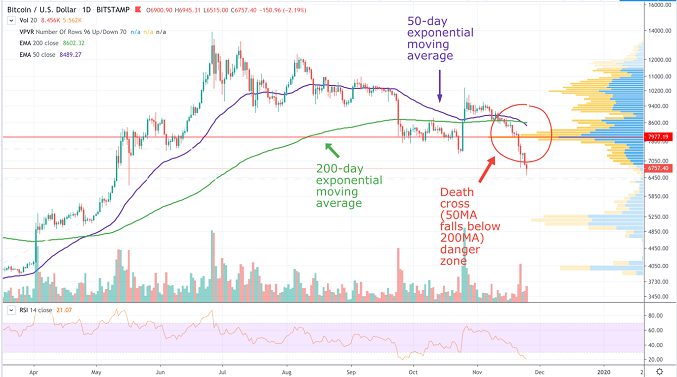Bitcoin crash: Buy the dip or run for the hills?
Always plenty going on in cryptoland, our award-winning crypto writer analyses latest price movements.
25th November 2019 13:43
by Gary McFarlane from interactive investor
Always plenty going on in cryptoland, our award-winning crypto writer analyses latest price movements.

Bitcoin has crashed through all its near-term support levels to $6,757 in the past few days as the sell-off deepened over the weekend.
Bitcoin is down 20% in the past seven days, trading at lows last seen in early May, with other leading crypto similarly impacted, with the worst placed top 10 coin being EOS, off 28%.
Market participants point to developments in China as the catalyst for the latest pull-back.
Although it has been obvious for some time, China has a two-track approach to the crypto space, differentiating support for blockhain initiatives in industry from the Wild West price speculation that has characterised much of what has come to be known as the ‘cryptocurrency’ industry.
Binance office raided in China says report
Binance, one of the largest crypto exchanges, which recently opened an office in China, was banned from Weibo last week. Weibo is China’s equivalent of Twitter. The TRON crypto network has received the same treatment.
That news was followed by rumours of a raid on Binance’s Shanghai office, following a report to that effect by crypto news outlet The Block. That has since been denied by Binance chief executive and founder Changpeng Zhao.
In response, the editor of The Block, Frank Chaparro, changed the headline of the original story to state it was a “visit” from the authorities as opposed to a raid, but stands by its claim that the Shanghai office has been “shutdown”. Whatever the exact truth of the matter, the damage to the bitcoin price set up has been done.
Although the renewed push by China into blockchain should be seen as positive for the global industry as a whole, many sellers are clearly interpreting the country’s clampdown on “actually existing” foreign blockchain projects based on value transfer networks as a negative.
As New York corporate lawyer Felix Shipkevich suggested to me in early October, well before the Xi Jinping blockchain speech, on the one hand China wants to move forward with putting digital cash on to blockchain distributed ledger technology, it does not want that happening before it has squeezed the exchanges and tokens that are the subject of speculative activity.
Shipkevich said:
“They are saying, before this gets out of hand and before our consumers start buying up these cryptocurrencies throughout the world and secretly move RMB out of China, we are going to try and prevent that and get them to use our own digital currency.”
He continued: “So, what I think China is doing – which is very smart in its own way – is to create this interest within the country to use its own digital cash – cryptocurrency that is backed RMB [The renminbi is the offshore version of the yuan], because essentially if you look at the progression of bitcoin and crypto you can see why.”
CoinShares’ Masters says bitcoin was probably overvalued
Danny Masters, chairman of CoinShares, the crypto exchange traded notes provider that recently launched a gold bullion-backed token called DGLD, thinks that bitcoin is probably overvalued at this point, judging by network activity and the lack of real-world blockchain product launches.
You can listen to the full interview with Masters at the interactive investor crypto podcast below.
“Given the level of traffic going through the network right now, bitcoin is probably overvalued by $1,000 to $1,500,” said Masters. He made that comment on 21 September after bitcoin was trading just below $8,000. On the strength of Masters’s prediction the price could now be nearing the bottom at circa $6,500.
However, the CoinShares chairman provided the caveat that network activity “is not the only thing going on” that could impact the price.
He thinks “good products, like ours [DGLD] and others, will bring the confidence back in bitcoin” plus added to that “halving does have an impact” on price. Bitcoin block rewards paid to miners will halve in May next year to 6.25 BTC, which will reduce bitcoin’s inflation rate – curtailed supply should increase the price of the leading crypto asset.
And coming back to the issue of product launches that could move the needle, Masters said:
“Between 2017 when the price peaked and now, there hasn’t been a lot of production but now we are at an inflection point and that changes the narrative.”
He has in mind central bank digital currencies from China and Switzerland, which he thinks could see the light of day next year and we will increasingly also see more “assets railed on crypto networks” such as CoinShares’ DGLD, which uses a bitcoin ‘sidechain’.
Of course, as far as products go, Facebook’s Libra initiative was probably the stimulus that led to the bitcoin price briefly rising above $13,000, the lack of progress of the project in the face of regulatory pushback has dampened sentiment almost as quickly as it initially helped.
Masters likens Facebook’s botched Libra launch as akin to “trying to create a space shuttle when the rest of us were trying to put four wheels on a car”.
Bitcoin bears come out to play
With bitcoin on a downswing, the bears have come out in force.
Last week, gold bug Peter Schiff, no fan of bitcoin on the basis of a head and shoulders technical set-up, postulates that the bitcoin price could fall to $1,000.
Hedge fund manager and founder of Dow Global Advisors, Mark Dow, another avowed bear in all things bitcoin, tweeted yesterday that “bitcoin will die a grinding death, punctuated by spoofs and FOMO spasms of decreasing frequency and intensity”.
Bulls will be encouraged that bitcoin is heavily oversold at these levels, according to the relative strength index, currently at 22, with levels under 30 deemed to be indicative of an oversold situation.
Bitcoin nears a bottom or does ‘death cross’ mean more pain?
But with the death cross in play – where the 50-day moving average (we show the exponential version on the chart) threatening to dip below the 200-day EMA – it will take brave souls to step in at this volatile juncture.

(BTC/USD 1-day candle on Bitstamp, courtesy TradingView)
Charles Hayter, chief executive of data provider CryptoCompare, has laid out the extent of the current volatility in comments provided to Bloomberg, suggesting it is par for the course for bitcoin. (Look out for a forthcoming ii podcast with CryptoCompare’s Karl Turner, head of business development and partnerships.)
“We are seeing 1,000 bitcoin trade per minute in dollars and 2,000 bitcoin using the stablecoin Tether, with the euro pair at 300 per minute. This is standard for the market with clusters of volatility, and buses seem to all come at once,” says Hayter.
If Masters is right a bottom may be forming at the lower end of his range around $6,500-$7,000, although he infers a $6,500 lower target in his comments provided on 21 September.
Bitcoin to $50,000 but not until a dump to $5,500?
Commodity trader Peter Brandt begs to differ with Tuur Demeester, founding partner at Adamant Capital, who claims bitcoin is still on a bullish track started in January 2015, with $50,000 the next bull market target.
Brandt thinks the price has to dip lower – to $5,500 – before the price starts a recovery and the next bull market truly awakens. He sees that bottom forming in July 2020, after the “halvening” in block rewards has taken place.
“Tuur, I think a prolonged journey below the line might be needed to thoroughly prepare BTC for the move to $50,000. The bulls must first be fully purged. When no bulls can be found on Twitter, then we will have a great buy signal,” said Brandt on Twitter (Saturday 23 September).
For now, the price has bounced off the intraday low of $6,546 at the time of writing.
Macro case for bitcoin still intact – buy the dip?
Despite the present bearish volatility, the macro case remains intact, although, as we reported last week, the return of risk-on sentiment in equities is certainly helping to spur selling in crypto, given the higher returns available there, especially if the trade war does get to the hoped for first phase deal.
In addition, although Facebook has experienced huge pushback against its plans for what would effectively be a ‘weightless’ (as in potentially not anchored to any one geographical region) global currency, it is not going to give up on the project because the prize is too large, even if the launch of Facebook Pay might suggest otherwise.
Whatever the cynics might think about Facebook boss Mark Zuckerberg’s recent testimony to the US Congress, his positioning of Libra as a way for the US to compete with China’s central bank digital currency plans has some merit.
This speaks to the fact that something of a power struggle is now in play between the US, Europe and China around how to deploy blockchain technology and which technical standards and regulatory frameworks will come to dominate.
That crypto-validating backdrop – despite those efforts being a far cry from the decentralisation mantra of supporters of public blockchains such as bitcoin – may provide a floor of sorts for the bitcoin price at current prices, which might encourage some ‘buy the dip’ interest.
These articles are provided for information purposes only. Occasionally, an opinion about whether to buy or sell a specific investment may be provided by third parties. The content is not intended to be a personal recommendation to buy or sell any financial instrument or product, or to adopt any investment strategy as it is not provided based on an assessment of your investing knowledge and experience, your financial situation or your investment objectives. The value of your investments, and the income derived from them, may go down as well as up. You may not get back all the money that you invest. The investments referred to in this article may not be suitable for all investors, and if in doubt, an investor should seek advice from a qualified investment adviser.
Full performance can be found on the company or index summary page on the interactive investor website. Simply click on the company's or index name highlighted in the article.